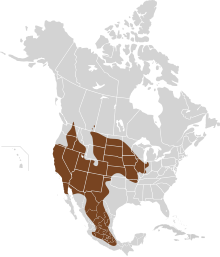
The harvest mouse is a small rodent native to Europe and Asia. It is typically found in fields of cereal crops, such as wheat and oats, in reed beds and in other tall ground vegetation, such as long grass and hedgerows. It has reddish-brown fur with white underparts and a naked, highly prehensile tail, which it uses for climbing. It is the smallest European rodent; an adult may weigh as little as 4 grams (0.14 oz). It eats chiefly seeds and insects, but also nectar and fruit. Breeding nests are spherical constructions carefully woven from grass and attached to stems well above the ground.

The smoky shrew is a medium-sized North American shrew found in eastern Canada and the northeastern United States and extends further south along the Appalachian Mountains.

The tundra shrew is a small shrew found in Alaska, the northern Yukon Territory, the MacKenzie Delta region of the Northwest Territories, extreme northwestern British Columbia and eastern Russia. At one time, this animal was considered to be a subspecies of the Arctic shrew.

The singing vole, is a medium-sized vole found in northwestern North America, including Alaska and northwestern Canada.

The western heather vole is a small vole found in western North America. Until recently, the eastern heather vole,, was considered to be a subspecies. They have short ears with stiff orange hair inside and a short thin tail which is paler underneath. Their long soft fur is brownish with silver grey underparts. They are roughly 14 cm (5.5 in) long with a tail length shorter than one-half their body length, approximately 50 mm (2.0 in). They weigh about 40 g (1.4 oz).
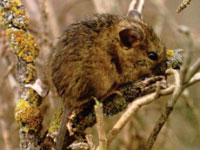
The salt-marsh harvest mouse, also known as the red-bellied harvest mouse, is an endangered rodent endemic to the San Francisco Bay Area salt marshes in California.

The short-tailed field vole, short-tailed vole, or simply field vole is a grey-brown vole, around 10 cm in length, with a short tail. It is one of the most common mammals in Europe, with a range extending from the Atlantic coast to Lake Baikal. These voles are found in moist grassy habitats, such as woodland, marsh or on river banks. Although they make shallow burrows, they usually build nests above ground. They are an important food source for owls and some other predators and their population size tends to peak and trough cyclically. Field voles breed prolifically, mainly in summer, but often all year round, even under snow. Females produce up to seven litters a year, each averaging from four to six young which are weaned after about fourteen days. The short-tailed field vole is both widespread and common and is listed as being of "Least Concern" by the IUCN.
The long-tailed birch mouse is a species of birch mouse found in Northeast Asia. It has been reported from the Ussuri region of Manchuria, Sakhalin Island and Primorsky Krai in Russia, and northern North Korea. It is listed as data deficient by the IUCN.

The northern birch mouse is a small rodent about 5 to 8 cm long, weighing 5 to 13 g. It lives in northern Europe and Asia in forest and marsh zones.
The Forrest's mouse, or desert short-tailed mouse, is a small species of rodent in the family Muridae. It is a widespread but sparsely distributed species found across arid and semi-arid inland Australia, commonly found in tussock grassland, chenopod shrubland, and mulga or savannah woodlands.
The fulvous harvest mouse is a species of rodent in the family Cricetidae. It is found in El Salvador, Guatemala, Honduras, Mexico, Nicaragua, and the United States.

The eastern harvest mouse is a species of rodent in the family Cricetidae. It is endemic to the Southeastern United States. Its natural habitats are subtropical or tropical seasonally wet or flooded lowland grassland, swamps, and pastureland.
The plains harvest mouse is a species of rodent in the family Cricetidae. It is found in northern Mexico and the central United States.

The yellow-nosed cotton rat is a species of rodent in the family Cricetidae. It is native to Mexico and to the states of Arizona, New Mexico, and Texas in the United States, where it inhabits mountain grassland, scrub, and pinyon-juniper woodland. It is common over much of its wide range and the IUCN considers it to be of "least concern".
The target rat is a species of rodent in the family Muridae. It is the only species in the genus Stochomys. Its natural habitat is subtropical or tropical moist lowland forests.
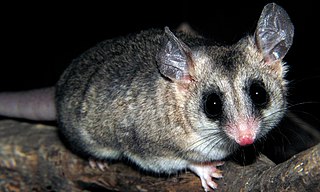
The elegant fat-tailed mouse opossum, also known as the Chilean mouse opossum, is an opossum from central Chile. The type species of Thylamys, it was first described by English naturalist George Robert Waterhouse in 1839. This medium-sized opossum is characterized by black rings around the eyes, white limbs, gray to light brown coat, lighter flanks and underbelly and a thick 12.7–14.6 centimetres (5.0–5.7 in) long tail covered with hairs. It is crepuscular and lives in nests in tree hollows or under rocks and roots. This opossum feeds mainly on arthropods and larvae apart from fruits. Litter size is typically between 11 and 13. The elegant fat-tailed opossum can occur in a variety of habitats – from cloud forests to chaparrals. The IUCN classifies the opossum as least concern.

The white-bellied fat-tailed mouse opossum is a species of opossum in the family Didelphidae. It is found in Argentina, Bolivia, Chile and Peru.
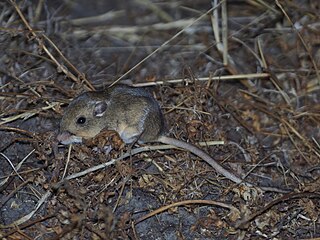
The San Joaquin pocket mouse or Salinas pocket mouse is a species of rodent in the family Heteromyidae. It is endemic to California in the United States where it lives in desert and semi-desert habitats.
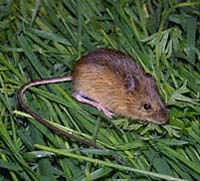
The Pacific jumping mouse is a species of rodent in the family Zapodidae. Found in Canada and the United States, its natural habitats are temperate grassland and swamps.

The Chihuahuan pocket mouse is a species of heteromyid rodent found in the southwestern United States and Mexico. It was formerly considered a subspecies of the desert pocket mouse, but was determined to be a distinct species in 1996, following analysis of its mitochondrial DNA.

